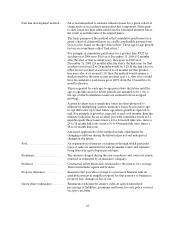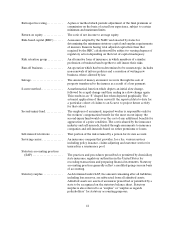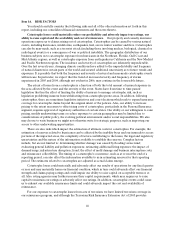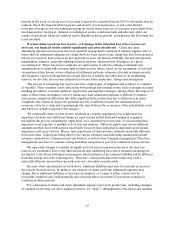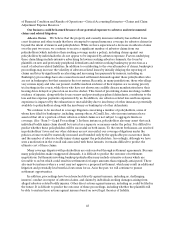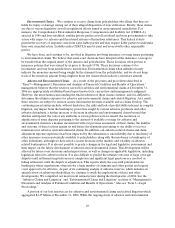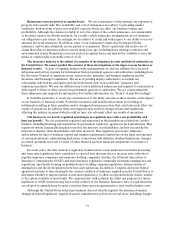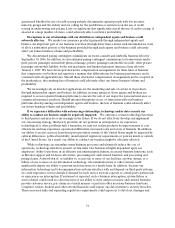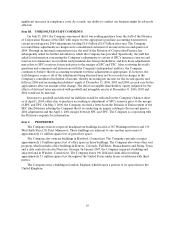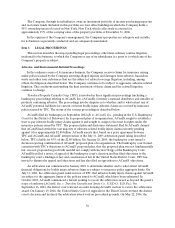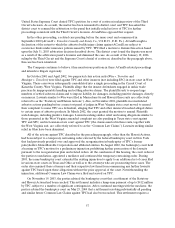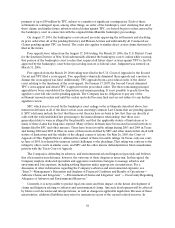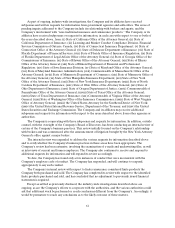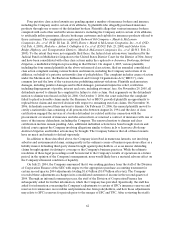Travelers 2006 Annual Report Download - page 64
Download and view the complete annual report
Please find page 64 of the 2006 Travelers annual report below. You can navigate through the pages in the report by either clicking on the pages listed below, or by using the keyword search tool below to find specific information within the annual report.52
in financial services regulation (e.g. the repeal of the McCarran-Ferguson Act) and federal taxation, can
significantly harm the insurance industry, including us.
A downgrade in our claims-paying and financial strength ratings could significantly reduce our
business volumes, adversely impact our ability to access the capitalmarkets and increase our borrowing
costs. Claims-paying andfinancial strength ratings have become increasingly important to an insurer’s
competitive position. Rating agencies review their ratings periodically, and our current ratings may not be
maintained in the future. A downgrade in one or more of our ratings could negatively impact our business
volumes, becausedemand for certain of our products in certain markets may be reduced or our ratings
could fall below minimum levels required to maintain existing business. Additionally, we may find it more
difficult to access the capital markets and higher borrowing costs may be incurred. If our capital position
were to deteriorate or one or more rating agencies were to substantially increase their capital
requirements, we may needto raise equity capital in the future in order to maintain our ratings or limit the
extent of a downgrade. For example, the frequency or severity of weather-related catastrophes in the last
two years may lead rating agencies to substantially increase their capital requirements. The ratings are not
in any way a measure of protection offered to investors in our securities and should not be relied upon with
respect to making an investment in our securities. For further discussion about our ratings, see, “Item 1—
Business—Ratings”.
Our investment portfolio may suffer reduced returns or losses which could reduce our profitability.
Investment returns are an important part of our overall profitability. Accordingly, fluctuations in the fixed
income or equity markets could impair our profitability.
Fluctuations in interest rates affect our returns on, andthe market value of, fixed income andshort-
term investments, which comprised approximately 94% of the market value of our investment portfolio as
of December 31, 2006. In addition, defaults by third parties, primarily from investments in liquid corporate
and municipal bonds, who fail to pay or perform on their obligations could reduce our net investment
income and net realized investment gains or result in investment losses.
We invest a portion of our assets in equity and real estate related investments, which are subject to
greater volatility than fixed income investments. General economic conditions, stock market conditions
and many other factors beyond our control can adversely affect the value of our equity and real estate
related investments and the realization of net investment income. As a result of these factors, we may not
realize an adequate return on our investments, may incur losses on sales of our investments and may be
required to write down the value of our investments, which would adversely affect our profitability.
The intense competition that we face could harm our ability to maintain or increase our profitability
and premium volume. The property and casualty insurance industry is highly competitive, and we believe
that it will remain highly competitive in the foreseeable future. We compete with both domestic and
foreign insurers, some of which have greater financial resources than we do. In addition, several property
and casualty insurers writing commercial lines of business now offer products for alternative forms of risk
protection, including large deductible programs and various forms of self-insurance that utilize captive
insurance companies and risk retention groups. Continuedgrowth in alternative forms of risk protection
could reduce our premium volume. Following the terrorist attack on September 11, 2001 and again
following the hurricane activity in2004 and 2005, a number of new insurers and reinsurers were formed to
compete in the industry, and a number of existing market participants have raised new capital which may
enhance their ability to compete.
Our competitive position isbased on many factors, including:
•our perceived overall financial strength,
•ratings assigned by independent rating agencies,
•geographic scope of business,


